Table of Contents
Where Do Microplastic Come From? The Hidden Sources Affecting Your Health Every Day
This page may contain affiliate links. We may earn a commission on purchases, at no additional cost to you. Learn more →
You reach for your morning coffee, slip into your favorite workout leggings, and start your day – but what if I told you that these simple actions are exposing you to thousands of tiny plastic particles that are now circulating through your bloodstream? Microplastics sneak into our daily lives without our awareness but where do microplastic come from?
Over 400 million tonnes of plastics are produced each year. Around 2 million tonnes of this plastic enters our oceans each year. Microplastics - plastic particles less than 5mm in size - enter our bodies through multiple ways and migrate through our bodies and have been detected in human tissue samples including the human brain - however, the long term implications of microplastics are still unknown! But recently, major blood vessels and human arteries detected with plastic particles in recent biopsy research has escalated health concerns dramatically.
In 2024, Nature published groundbreaking research showing that brain tissue may contain 10 times more microplastics than other organs - with the average amount being equivalent to the amount found in a standard plastic spoon. This study also highlights the increasing concentration of microplastics found in 2024 brain samples compared to those from 2016.
But here's what gives me hope: once you understand where these invisible invaders come from, you can take simple, practical steps to protect yourself and your family. As someone who's spent years researching non-toxic living, I've learned that knowledge is your first line of defense.
So how are microplastics getting in our bodies, and what can you do to protect yourself?
In this comprehensive guide, I'll walk you through the hidden sources of microplastics in your daily life and share the practical, science-backed strategies I've discovered to reduce your exposure starting from today!
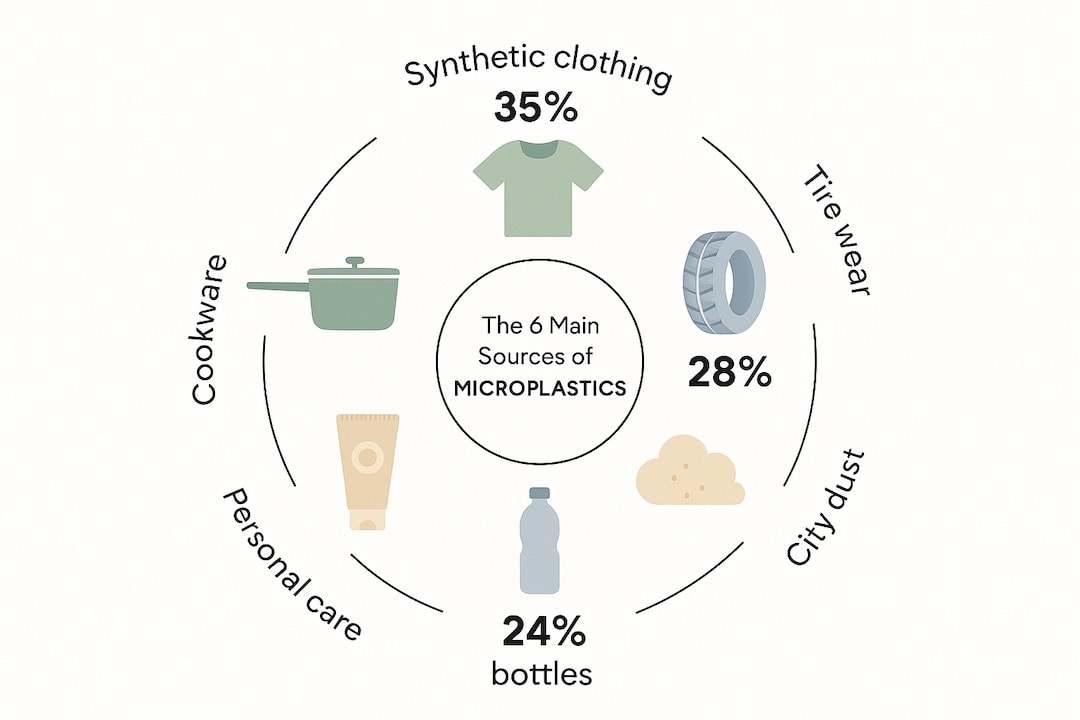
Key Taskeaway
-
Microplastics are everywhere—even in you - From bottled water to your gym leggings, tiny plastic particles are entering our bodies daily. Human tissue analyses has revealed microplastics in organs like the brain, lungs, and even the placenta. The long-term health effects are still being uncovered
-
Everyday habits are the biggest culprits - Drinking bottled water, wearing synthetic clothes, using plastic containers, and even chewing gum all contribute to microplastic exposure—often without us realizing it
-
Our food and water are contaminated - Seafood, salt, sugar, and even beer can contain microplastics thanks to ocean pollution and plastic packaging. One litre of bottled water alone can have up to 240,000 plastic particles!
-
What you wear and wash matters - Washing synthetic fabrics releases hundreds of thousands of microfibres into the water system. These eventually find their way into our environment—and back onto our plates
-
Small swaps make a big difference - Switch to natural fabrics, avoid plastic packaging, use water filters and HEPA air purifiers, and choose clean beauty products. Every step helps protect your health—and the planet
Understanding Microplastics: What You're Really Dealing With
Before we dive into where these particles come from, let's get clear on what we're talking about. Microplastics are plastic fragments between 1µm and 5mm in diameter – that's approximately 1/100th the width of a human hair. You might spot them as multicolored ribbons on beaches, but in the ocean and in our bodies, these particles are often invisible to the naked eye.
Scientists classify microplastics into two main categories that directly impact how they enter your life:
-
Primary microplastics are manufactured small and enter the environment directly as tiny particles. These include microfibres from your synthetic clothing, microbeads in cosmetics, and even glitter from craft projects. Think of these as the plastic particles that were designed to be small from the start.
-
Secondary microplastics form when larger plastic items break down due to UV radiation, physical wear, or chemical processes. Your plastic water bottle, food packaging, fishing nets, and even tire wear particles all contribute to this category. These start big and become microscopic over time.
What makes this particularly concerning is that microplastics have been detected in everyday foods we trust: beer, drinking water, honey, cooking salt, and even sugar. This isn't happening in some distant factory – it's happening in your kitchen, in your closet, and in the products you use every single day.
Where Do Microplastic Come From? The 6 Hidden Sources in Your Daily Life
Most of us ingest a significant amount of microplastic without realising, through our food, through the air that we breathe, and even through direct skin absorption with the products we use daily! To date, microplastics have been detected in beer, drinking water, honey, cooking salt, and even sugar!
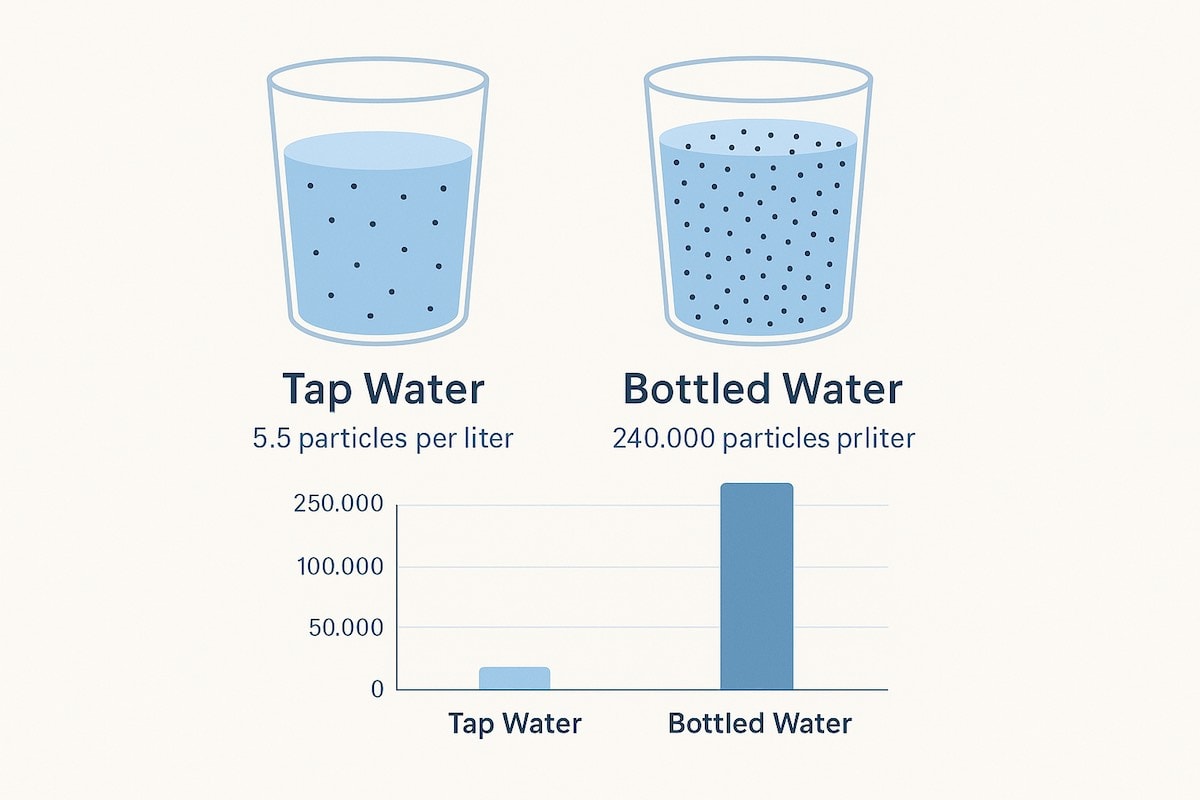
1. Your Drinking water: Tap and Bottled Water - The Shocking Truth About What You're Actually Consuming
Studies have revealed microplastics are in about ~83% of tap water (, and ~90% of bottled water. One litre of bottled water included around 240,000 tiny pieces of plastic, compared to just 5.5 particles in a litre of tap water ! Microplastics are no doubt seen in higher concentrations in bottled water compared to tap, specifically in PET packaged water, with even the bottle caps being a significant source of microplastics released into bottled water! Highlighting that the bottling process and opening of bottled water itself significantly contributed to microplastic contamination!
This reflects the exponentially rising environmental presence of microplastics in consumer products, due to the heavy contamination in our water. What started as a convenience has become a daily source of plastic consumption.
2. Your Food: From Ocean to Plate, Microplastics Are Everywhere
Seafood: The Ocean's Plastic Problem Becomes Yours
If you enjoy seafood, you need to know this: 40-80% of marine litter is plastic, and marine animals are consuming it daily. With world fishery production reaching about 179 million tons in 2018, that's a massive amount of potentially contaminated seafood entering our food system.
Smaller fish typically pose a higher risk of microplastic contamination compared to larger fish where the gut is removed. However, microplastics have been found in many species intended for human consumption, including crabs and mussels. The plastic particles these animals consume don't just disappear – they become part of the food chain that ends on your dinner plate.
Pro tip: If you're interested in learning more about ocean plastic pollution and its impact on marine life, I recommend watching "Seaspiracy" on Netflix. It provides eye-opening insights into how plastic pollution affects the seafood we consume.
Salt: Your Daily Seasoning Contains Plastic
This one really opened my eyes: a comprehensive 2019 study analyzed salt samples from 21 countries worldwide and found that 90% of table salt brands contain microplastics. The highest concentrations were found in salt from Indonesia, but no region was immune.
Here's what this means for your daily life: the average adult could ingest 2,000 microplastics per year through salt consumption alone. That's just from seasoning your food – not counting all the other sources we're about to discuss.
This widespread contamination points to the global nature of microplastic pollution. Even something as basic as salt, which we use daily without thinking, has become a vehicle for plastic consumption.
3. Clothing and Textiles: How Your Clothes Are Polluting Your Body
This might be the most surprising source of all: your clothing. Did you know that synthetic fabrics like polyester, nylon, and acrylic are leading sources of microplastic pollution? With just one wash of polyester clothing, you could be releasing up to 700,000 plastic fibers into water systems. In fact, 35% of microplastics in our oceans comes from clothing alone.
But the contamination doesn't stop when you take your clothes off. Microplastics can enter your body through direct skin contact, especially when you're sweating. A 2023 study found that sweating in synthetic materials can leach toxic chemicals like PFAS from microplastics directly into your skin.
Think about this: if you're wearing synthetic workout clothes during exercise, when your pores are open and you're sweating, you're creating the perfect conditions for microplastic absorption. This is particularly concerning for those who exercise regularly in synthetic activewear.
The problem extends beyond just wearing these clothes. When you wash synthetic garments, those 700,000 microfibers don't just disappear – they enter wastewater treatment plants. These facilities can't filter particles this small, so they're discharged with treated wastewater, eventually finding their way back into our water supply and food chain.
Even your laundry detergent might be adding to the problem. The Austrian Environmental Organization tested 300 detergents and found that 119 contained microplastics. So you're potentially adding plastic particles while trying to clean plastic particles from your clothes.
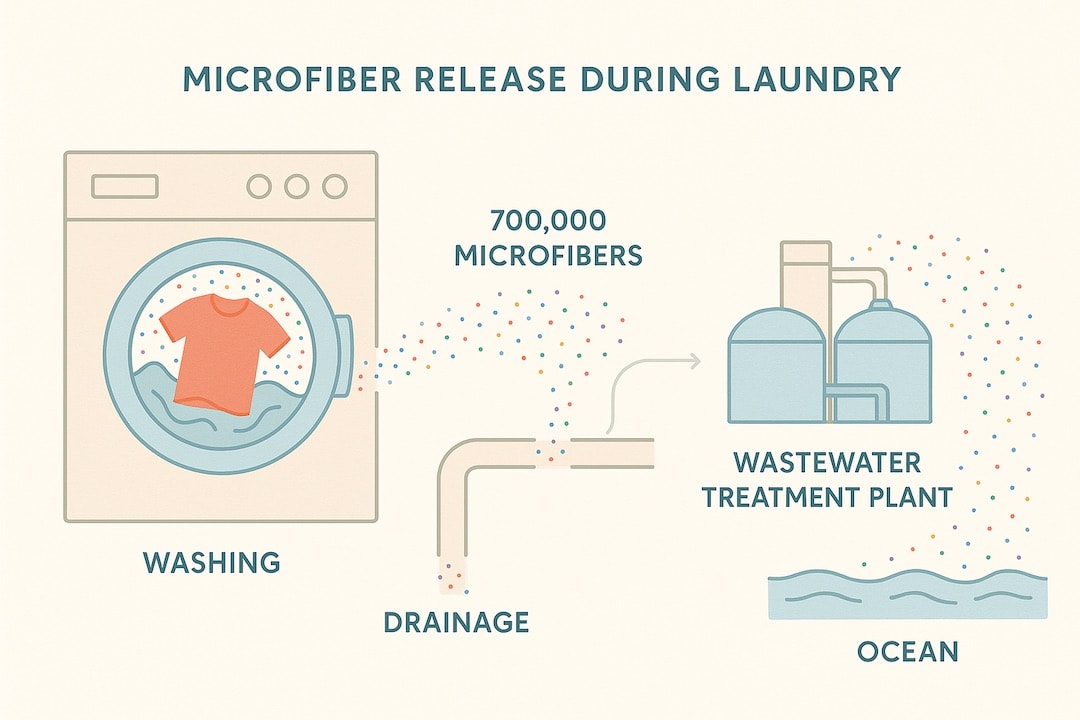
4. Your Personal Care Routine: Hidden Plastics in Everyday Products
Before the US banned microbeads in 2015, these tiny plastic particles were common in facial scrubs, body washes, and toothpastes. But don't assume the problem is solved. A 2021 report by the Plastic Soup Foundation found that 87% of products from the top 10 cosmetic brands still contain microplastics – that's 9 out of 10 products.
These products include primers, foundations, glitters, and even some hair conditioners. Up to 10% of some personal care products' weight is plastic – more than the packaging material itself. Some items contain several thousand microbeads per gram of product.
Here's something that might shock you: almost all commercial chewing gum is made of plastic. The "gum base" listed in ingredients is usually a blend of rubbers and plastics – the same materials used in car tires and adhesives. These synthetic bases are not biodegradable, and since gum is chewed directly, microplastics may be ingested through the chewing process itself.
When you use these products, the microplastics don't just wash down the drain – they can be absorbed through your skin or accidentally ingested. Once in wastewater, these particles easily pass through filtration systems and end up in our waterways, creating a cycle of contamination.
5. Your Kitchen: How Cooking and Food Storage Add to Your Plastic Load
Non-Stick Cookware: The Hidden Danger in Your Pan
Non-stick cookware is coated with PTFE, better known by the brand name Teflon. While it makes cooking easier, this coating degrades over time, especially at high temperatures or when the surface gets scratched.
Research published in 2022 in Science of the Total Environment revealed a disturbing truth about non-stick cookware: even a single scratch on your Teflon-coated pan can unleash up to 9,000 microscopic plastic particles directly into your meal, that enter your digestive system and gradually build up in your body tissues over time.
Think about how often you use non-stick pans and how easily they get scratched with regular use. Every time you cook with a damaged non-stick surface, you're potentially adding thousands of plastic particles to your meal.
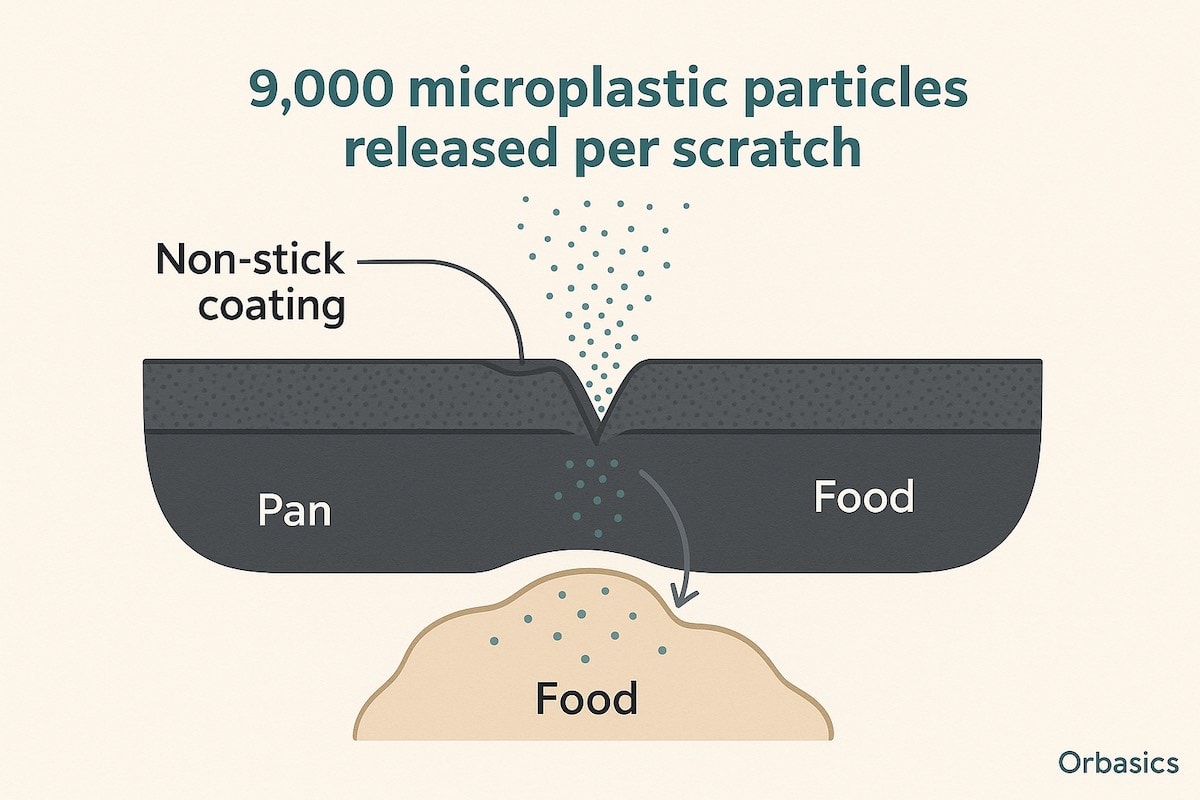
Plastic Food Containers: Heat Makes Everything Worse
Plastic food containers become particularly problematic when heated. When you microwave food in plastic containers or store hot food in plastic, you're increasing the chance of chemical leaching, especially of chemicals like Bisphenol A (BPA) and phthalates.
The risk is so significant that the American Academy of Pediatrics advised against using plastic food containers, cling film, and microwaving in plastic – especially for children – due to potential health consequences.
6. Your Environment: The Air You Breathe and the Roads You Travel
Tire Wear: The Invisible Pollution from Every Drive
Every time you drive, your tires are wearing down and releasing microplastics into the environment. About 24% of a tire consists of synthetic rubber (a plastic polymer), with the rest being natural rubber, metal, and other compounds. Tires erode through heat and friction from road contact, and wind and rain spread this tire dust, washing it into tributaries, lakes, and eventually oceans.
Canadian scientists tracked how passenger vehicle tires lose approximately 2.5 pounds of material during their standard six-year lifespan. This wear pattern, when multiplied across all American vehicles, produces about 1.8 million tons of tire-derived microplastics annually. According to the International Union for Conservation of Nature, these automotive particles contribute 28% of all primary microplastics entering ocean systems.
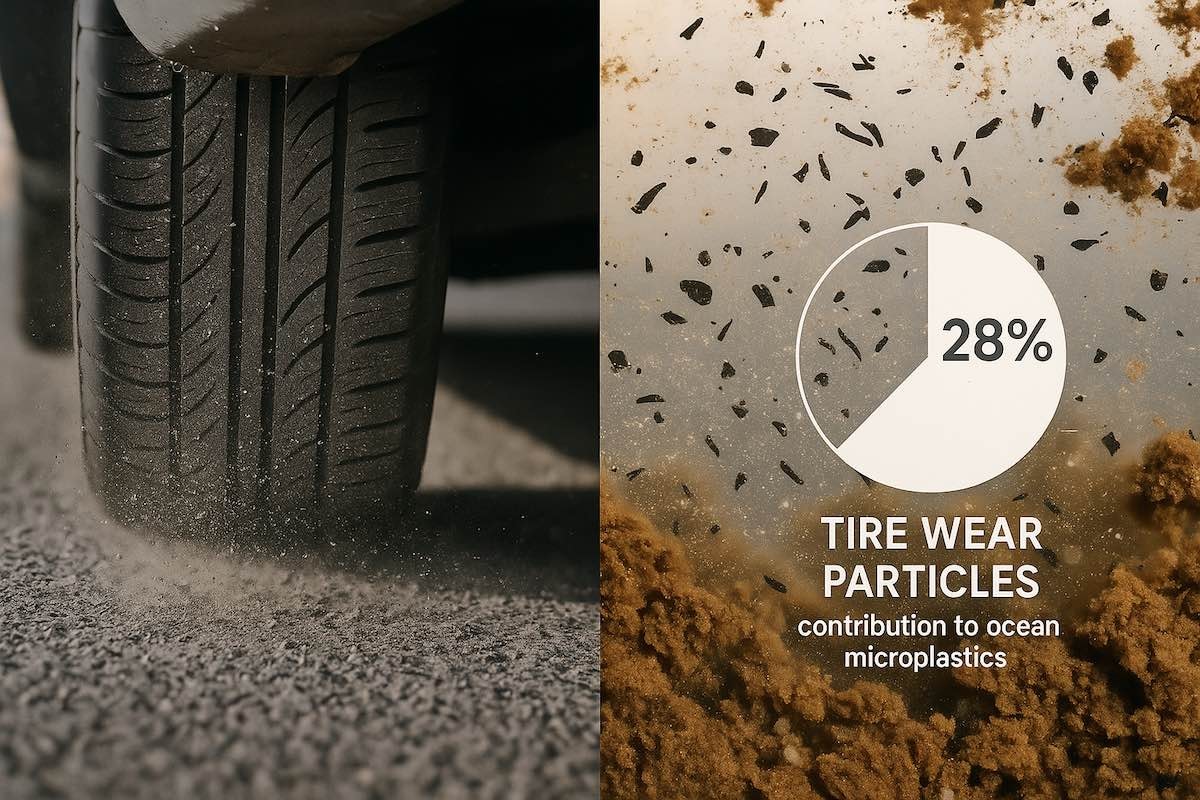
City Dust: The Urban Microplastic Cocktail
City dust accounts for 24% of microplastics in the oceans and comes from numerous sources. This includes synthetic shoe soles, cooking utensils, household dust, artificial turf, building coatings, and particles from weathering plastic materials.
Researchers monitoring air quality in the remote Pyrenees Mountains of southern France discovered a shocking reality: even in this pristine wilderness, located 60 miles from the closest urban center, microplastic particles are literally raining down from the sky. Their measurements revealed that 365 microscopic plastic fragments settle on every square meter of mountain terrain daily.The researchers called it a "new atmospheric pollutant," showing that microplastics can travel vast distances through the air we breathe.
Human Health Risks: The Risks of Microplastics
When these tiny plastic particles enter your body, they don't just pass through harmlessly. They can accumulate, travel through your bloodstream, and interact with major organ systems, resulting in a plethora of potential health risks due to difficulty in removing microplastics from the body! Advanced techniques such as transmission electron microscopy have detected microplastics that some of the places microplastics may deposit include:
-
Lungs - especially in polluted cities or near construction sites, these particles can get inhaled into your respiratory system. A 2022 study reported that microplastics have been found in 11 out of 13 lung tissue samples from patients undergoing surgery!
-
Once embedded in your lungs, microplastics may cause breathing issues, chronic inflammation and even exacerbate conditions like asthma!
-
-
Gut, Liver and kidneys - Whether its bottled water, salt or processed food wrapped in plastic, once swallowed these particles can enter your bloodstream through your gut and travel to your liver and kidneys which are common deposit sites for microplastics, confirmed by a 2024 study in solid tissue samples!
-
Various studies in mice using digestion and measurement processes have demonstrated the risks of microplastics on the kidneys and the liver, including inflammation, increase of stress markers and abnormal development of organs. Long-term there are concerns that the rise of microplastic ingestion may result in chronic health conditions!
-
-
Brain tissue - Yes, this is hard to believe but microplastics are small enough to reach the human brain by crossing the blood brain barrier. Confirmed by the 2024 study published in Environmental Health Perspectives, in which scientists from the University of New Mexico found microplastics in human brain tissue, which may trigger inflammation and how your brain cells communicate. In fact, researchers round that the brain had some of the internal maximal concentrations of microplastics compared other organs.
-
While the long-term studies are still being investigated, early research suggests possible links to cognitive decline, neurotoxicity and even neurodegeneration
-
-
Placenta tissue - The first evidence of microplastic in human placenta tissue was discovered in 2020, in which 6 human placental specimens were analysed, and researchers found 12 microplastic fragments across 4 of the 6 placenta samples
-
Although the full implications are not fully understood, these findings raise serious red flags, with concerns around fetal development, hormone regulation (as plastics are known endocrine disruptors), and early growth in babies!
-
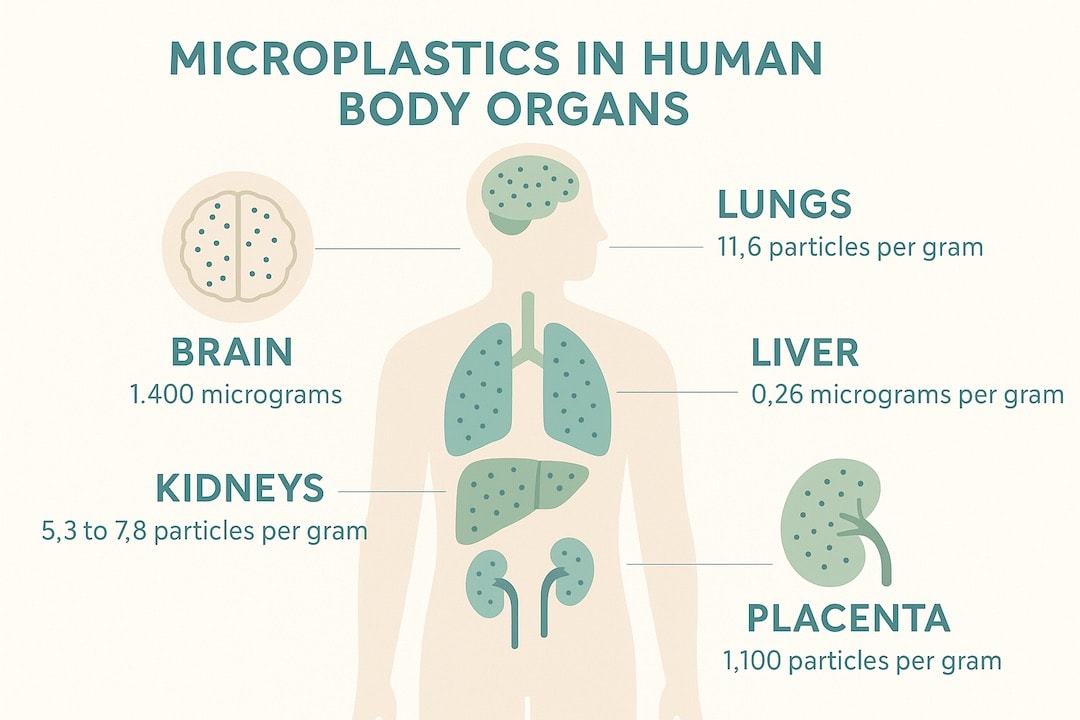
Your Action Plan: Simple Steps to Reduce Microplastic Exposure
The good news? You don't have to feel helpless. There are practical, achievable steps you can take starting today to significantly reduce your microplastic exposure. I've organized these by impact level, so you can prioritize the changes that will make the biggest difference.
-
Avoid Synthetic Fabrics: Your clothes are the biggest source of hidden plastics, espeically when you're hot and sweaty as these fibers are more easily absorbed through your skin.
-
Instead switch to natural materials like cotton, linen or wool. Looking for trusted certifications like OEKO-TEX or GOTS trademarks when shopping to reduce your exposure
-
-
Use a Microfiber Filter: If switching is not a feasible option of you, consider using a microfiber filter in your washing routine.
-
Products like the Guppyfriend washing bag or a Cora Ball are external washing machine filters designed to trap microfibres before they enter the water system - and eventually, the food chain!
-
-
Filter Your Air: In homes with a lot of synthetic materials, or near urban pollution, regularly vacuuming or investing in an air purifier can help reduce microplastic concentrations
-
A HEPA filter is a great option to trap these microplastics and improve your air quality, espeically in children's spaces
-
-
Avoid Plastic Packaging and Bottled Water: If you're anything like me and dislike the use of plastic water bottles, invest in a reusable water bottle or use a water filter!
-
Glass or stainless steel reusable water bottles not only improve the taste of the water, but they reduce your exposure to BPA, especially in the heat when your plastic water bottle can leach into your water!
-
-
Avoid Plastic Bags and Packaging: When possible purchase food items that come in plastic-free packaging and buy fresh, unpacked food, and avoid pre-packaged, processed foods to reduce potential plastic contamination
-
Metal and glass tupperware are the best option for storing and heating food. Buy fresh, unpackaged produce and avoid pre-packaged, processed foods and limit seafood when possible to reduce microplastic exposure
-
-
Replace Non-Stick Cookware: Switch to stainless steel, cast iron, or ceramic cookware to eliminate PTFE exposure from scratched non-stick surfaces
-
If you must use non-stick pans, use low heat when possible, never preheat an empty pan and throw out once the surface is damaged!
-
-
Switch to Natural Beauty Products: When possible - and this will take some practice, choose natural toothpaste and scrubs with natural exfoliants!
-
Look for certifications like Plastic Soup Foundation's Zero Plastic Inside logo or eco-certified alternatives where all ingredients are listed!
-
Replace your commercial chewing gum for brands that instead use natural ingredients like Chiche that utilises natural tree sap instead!
-
To learn more actionable ways to reduce your exposure, check how to avoid microplastics.
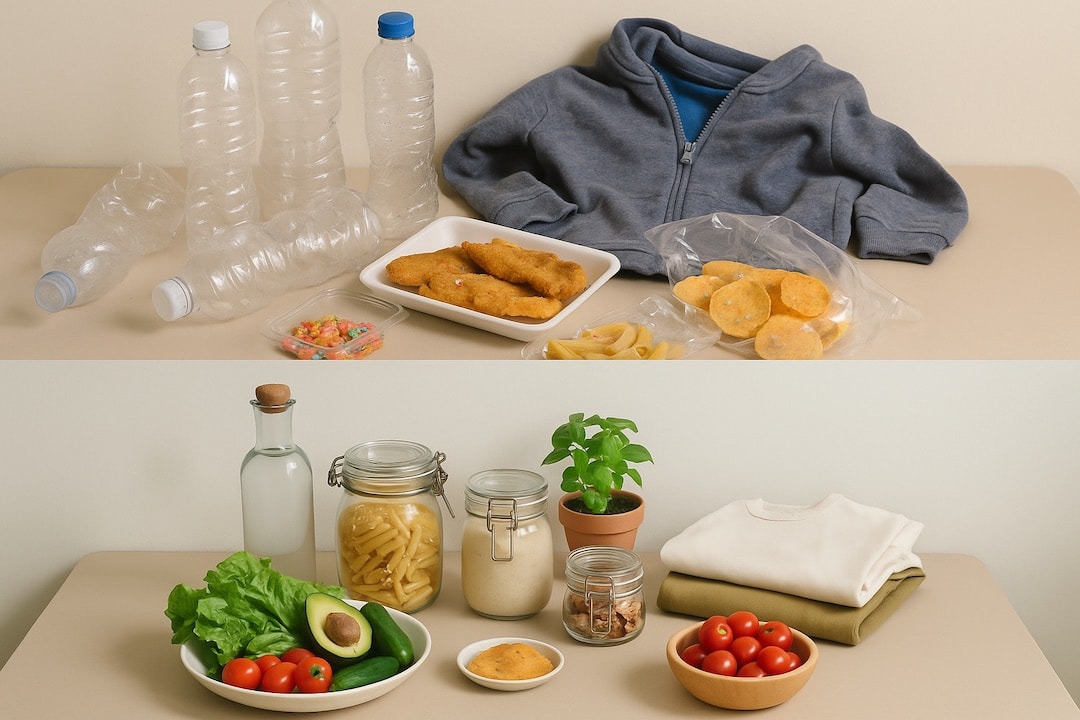
The Bigger Picture: Why Your Choices Matter
Every small change you make doesn't just protect your health – it sends a message to manufacturers about what consumers want. When you choose natural fabrics, glass containers, and plastic-free products, you're voting with your wallet for a less toxic world.
The microplastic problem didn't happen overnight, and it won't be solved overnight. But by understanding where these particles come from and taking practical steps to reduce your exposure, you're protecting your health while contributing to a larger movement toward safer, more sustainable products.
FAQ to Where Do Microplastic Come From
Where do most microplastics come from?
The majority (roughly 70 - 80%) originate as secondary microplastics: tiny fragments produced when mismanaged macro-plastics (packaging, fishing gear, agricultural film, etc.) degrade in the environment
What is the primary source of microplastics?
Among primary categories, synthetic textile fibres released during laundering and wear form the single largest share (≈35%), followed closely by tyre-wear particles.
What is the root cause of microplastics?
At its core, microplastic pollution is driven by a linear plastic economy that prioritises inexpensive, disposable, and synthetic-polymer products without built-in recovery or durability safeguards. The combination of: High volume production,low recycling and poor waste management, and material choices that shed during normal use creates a continuous, systemic feed of both primary and secondary microplastics into air, soil, rivers, and oceans
Do microplastics actually harm you?
While research is ongoing, current studies show microplastics can accumulate in vital organs including the brain, lungs, liver, and kidneys. They may cause inflammation, disrupt hormone function, and potentially contribute to various health issues. The precautionary principle suggests minimizing exposure while research continues.
Is a spoon of microplastics in the brain?
Recent 2024 research found that the average human brain contains microplastics equivalent to about one standard plastic spoon in weight. This represents a significant increase compared to samples from 2016, indicating growing contamination over time.
What are the symptoms of microplastics?
Currently, there are no specific symptoms directly attributed to microplastic exposure, as research is still emerging. However, research links high body burdens to inflammation, altered coagulation and possible cardiovascular risk













